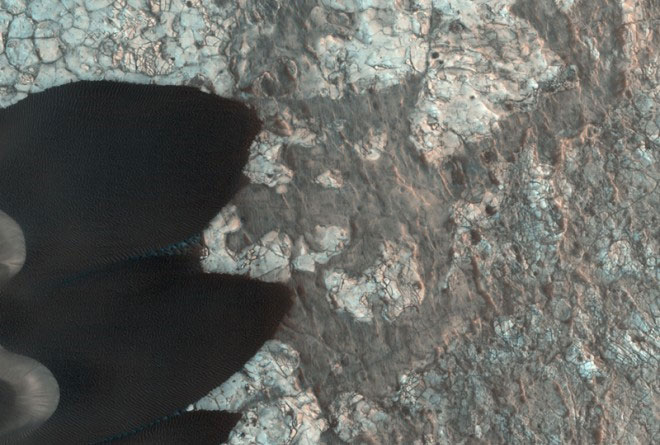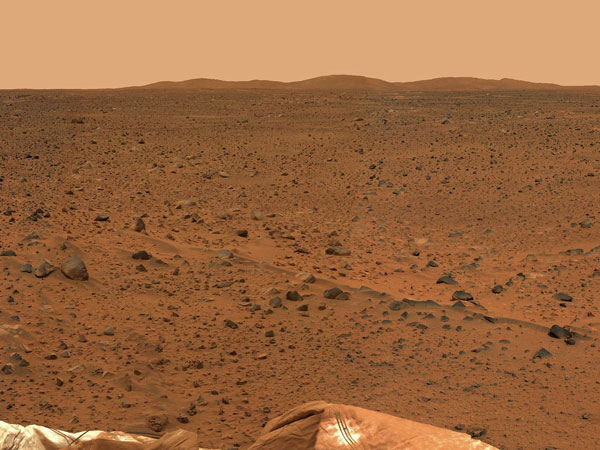The surface of Mars is still inactive
In the 1890s, when Percival Lowell first saw Mars through a telescope, he discovered some noticeable features on the planet, namely: there were many grooves intersecting each other on the surface. The face of the planet, connecting many points far from each other on the surface of 'red sphere'.
According to him, the observed tangled lines do not look like they exist naturally. In other words, they were created intentionally. Therefore, he quickly agreed with the view of the Italian astronomer - Giovanni Schiaparelli that the interlacing lines are the canals created by humans on Mars to meet the needs of consumer water in their life.

If the Earth people know how to dig rivers and dig canals, why are aliens not thinking about this? Not only that, Percival Lowell has published many books about Mars to publicize his inferences. Typical of these include books like Mars, Mars and its canals, Mard as the abode of life. When these works are published, the scientific community and many people agree with the speculations mentioned therein.
However, the reality is not so. About a few decades later, when the Mariner 4 space probe was put on the red planet and obtained a cluster of Martian surface images, the results were quite disappointing. Because, the canals Percival Lowell had seen before, according to the observed image, were essentially frozen lakes on the crater. And certainly, there is no such a system of organized canals on Mars as people had predicted and believed before.

A lot of research has been done since then to find reliable evidence of Mars's secret from a highly volatile planet until it becomes a frozen planet like now and there are no more surface changes. However, there are also results showing the ongoing activities of large sand dunes on Mars. One of those results was given by the members of the Mars detective mission (NASA's Mars Reconnaissance Orbiter mission).
Software engineers as well as image analysts of the California Institute of Technology Research (USA) analyzed the photos that were transferred from high-resolution cameras (High Resolution Imaging Science Experiment camera). The team followed the images of Nili Patera sand dunes covering about 300 km 2 on the Martian surface for about 105 days. At the same time, they also used measurement and calculation programs to monitor changes in the shape and coverage of sand dunes. And the results were also very encouraging, they saw the change, the dunes expanded 4.5m. According to software engineer Francois Ayoub - a member of the research team, 'all dunes tend to move. There seems to be no sand dunes at all . ' This means that the surface of Mars is still changing.

Evidence of the surface movement of Mars has been recently discovered, but the speed and extent of sand dunes need to be further studied. According to the leader of this research group - Jean-Philippe Avouac, 'wind is an important factor affecting the change on the surface of Mars. Research on the wind on Mars is extremely important, as this will help us to know the current situation as well as predict the future changes of the Martian surface . " According to him, the The wind on Mars has the same speed as the wind that blows on Earth, and a wind on this red planet has the same level as the wind in a level 8 storm on Earth.
However, there are still questions surrounding this wind-blown issue: The dunes expand frequently with constant speed or only when there are breezes do the dunes expand. And all the dunes are wide open or only some?

The research team at the California Institute of Technology is still looking for answers. Photographs of Mars on a wider scale but still more clear are still being studied. It is possible that active volcanoes or floods are only the past of Mars, but Mars is still undergoing other geographical changes. These changes are caused by the activity of winds on the Mars surface. And when these winds still blow, people still have the right to believe this is not a dead planet, at least geographically. This means we will have more hope in the search for life on Mars.
Reference: Wired
- 'White Christmas' on the surface of the red planet
- Mystery of life beneath the surface of Mars
- New discovery of life survival under the surface of Mars
- Mars may contain a giant ice lake
- Discovering a 130-meter-thick ice shelf hidden under the surface of Mars
- Mars contains more groundwater than Earth?
- Detecting a 20km lake under the surface of Mars
- The photos prove there is water flowing on Mars
- NASA explains the confusing
- NASA ships find gray stones on the surface of Mars
- Disclosure is little known about the plan to explore ice on Mars
- Is water still below the surface of Mars?
 Van Allen's belt and evidence that the Apollo 11 mission to the Moon was myth
Van Allen's belt and evidence that the Apollo 11 mission to the Moon was myth The levels of civilization in the universe (Kardashev scale)
The levels of civilization in the universe (Kardashev scale) Today Mars, the sun and the Earth are aligned
Today Mars, the sun and the Earth are aligned The Amazon owner announced a secret plan to build a space base for thousands of people
The Amazon owner announced a secret plan to build a space base for thousands of people